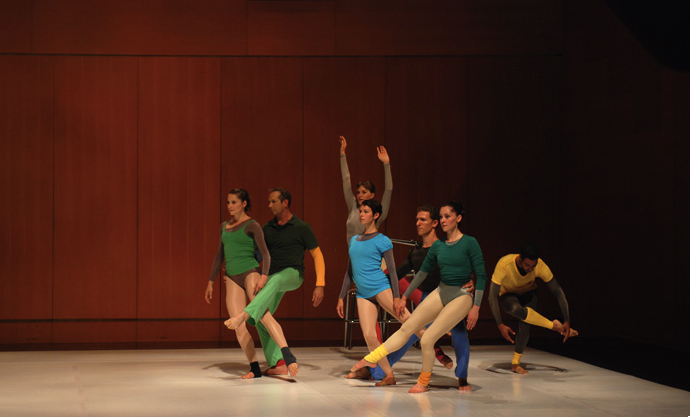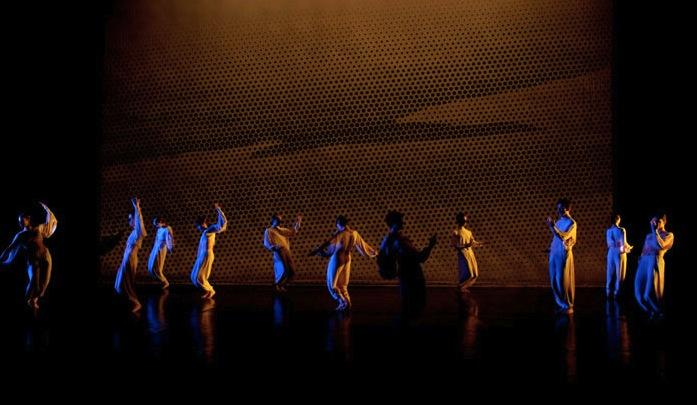Any newcomers to Merce Cunningham who visit the last performances ever in Britain of his modern dance company - renowned, even notorious, for its abstruse abstractness - will surely go away with an impression of laughter, playfulness, the lightness of being. On two more nights, tonight and tomorrow, this landmark company will perform his dances, and then - like the end of his piece Ocean, which you can see on film tomorrow - when the clock runs out, the last dancer will leave the stage, and that will be the end of it.
Few choreographers plan their finale as exactly as Cunningham did before he died, aged 90, in 2009. A two-year “legacy” tour around the globe, dancing choice pieces to the audiences who’d loved and sought out this inimitable dance-maker, London high on the list, having offered the Americans almost a second home in the past 20 years.
 Last night we had the revivifying Roaratorio, which is like a dance class in the city that keeps breaking out into an Irish get-together, dancers in mix-and-match colours, holding hands and jigging, while sounds fly in as if through an open window - traffic, children in the park, snatches of Irish fiddle-playing, chunks of James Joyce poetry, a crooning vagrant wandering by. The score is one of the many made for Merce, his partner, by John Cage, the mischievous, ever-stimulating composer and apostle of chance.
Last night we had the revivifying Roaratorio, which is like a dance class in the city that keeps breaking out into an Irish get-together, dancers in mix-and-match colours, holding hands and jigging, while sounds fly in as if through an open window - traffic, children in the park, snatches of Irish fiddle-playing, chunks of James Joyce poetry, a crooning vagrant wandering by. The score is one of the many made for Merce, his partner, by John Cage, the mischievous, ever-stimulating composer and apostle of chance.
The dancers skip and leap, or relax on bar stools at the side, watching each other. There is no beginning, middle or end, though the light faintly dims as if the day is passing; there is only your attention span, which - as far as I was concerned - becomes limitlessly tolerant of this balmy experience. Roaratorio is danced again tonight, and if you have any tensions in your life, I recommend its therapy.
Sadly there’s no repeat for the first night, a trio of dances embracing the witty, impish Fifties Merce, the mysterious, compelling Seventies Merce and the astonishing, computer-tooled Merce of the Nineties. Decors by Roy Lichtenstein, Jasper Johns and Robert Rauschenberg reminded you that Cunningham was a leading catalyst for America's Abstract Expressionism movement, music by Cage and by Brian Eno told you of Cunningham’s allure for contemporary experimental composers. Tomorrow’s programme, the final farewell, has Andy Warhol and the digital inventors Shelley Eshkar and Paul Kaiser on the collaborators’ list.
Such names only, really, for Cunningham - his method of commissioning music and decor independently of his choreography (he would give a time period only to them, no name, no theme, it was up to them) produced again and again works that somehow gelled to arouse a feeling, an association, an emotion. He never asked for emotion, but you very likely felt it, virus-like, infecting the hard drive.
Pond Way, seen on Wednesday, may have been chosen for this tour because, for once, name, sound and visual impression are unusually united - this is virtually a Monet in dance. One can easily read in the soft pixellated black-and-white abstract of Lichtenstein’s a smudge of a water lily here, the hollow of a ripple there. Eno’s composition for “three CD players”, New Ikebukuro, is quiet, meditative, dappled music, and the dancers, in white draped costumes, skip and hop as lightly as mayflies on the water’s surface. Yet the moves they do were built on computer, demands evidently exceeding the capability of even his own dancers the other night, flipping unlikely assortments of leg, arm and torso instructions together.
 That pre-computer Cunningham was doing boldly inventive things to the way the body moves was powerfully evident in Second Hand, from 1970, which we’d never seen in Britain before. In an empty black stage, costumed in Smartie-coloured unitards by Jasper Johns (pictured left), this launched with a breathtaking solo for a man, once Cunningham himself, and now his veteran disciple, Robert Swinston. A pianist in the pit picks out with a single finger something a little like a Bach fugal theme, which becomes an unending string of single notes, sometimes doubled in octave with the other hand, but never adding any harmony, seeming to have no destination.
That pre-computer Cunningham was doing boldly inventive things to the way the body moves was powerfully evident in Second Hand, from 1970, which we’d never seen in Britain before. In an empty black stage, costumed in Smartie-coloured unitards by Jasper Johns (pictured left), this launched with a breathtaking solo for a man, once Cunningham himself, and now his veteran disciple, Robert Swinston. A pianist in the pit picks out with a single finger something a little like a Bach fugal theme, which becomes an unending string of single notes, sometimes doubled in octave with the other hand, but never adding any harmony, seeming to have no destination.
Because Swinston is into his sixties now, his halting quality of movement now layers a strong association of questions, hesitation, onto these eccentric moves - it became a metaphor for an older man searching for answers, and I thought very moving. A younger woman joins him in what becomes a sort of pas de deux. They look intently into each other’s faces as they join hands, her leaps are small, light, effortless, with a balletic grace, they are the two faces of time, looking back and looking forward. The group that then joins them appears to swallow her up, leave the man isolated in a spotlight, his hand signalling for rescue, looking for her. I have once again fallen into the trap of reading a narrative into a Cunningham piece, but it’s an impulse I can’t resist, so richly and uninhibitedly did those dancers embed humanity into that wonderful piece.
 Antic Meet, the earliest piece from 1958, made a killer of a finale, a madly funny and crisply timed vaudeville, a kind of Have I Got Dance for You satire on modern life and culture. A man with a chair tied to his waist (Theatre of the Absurd), an eagerly yielding woman in a frilly country pinny (Martha Graham), sudden appearances of bunches of flowers or an umbrella with Christmas lights on, chic black-sunglasses-wearing babes in black, a chap lost in an outrageous sweater with far too many sleeves and no opening for the head. His encounter with can-can girls dressed in parachutes (pictured right) is the giddiest comedy of teenage inadequacy you'll ever see.
Antic Meet, the earliest piece from 1958, made a killer of a finale, a madly funny and crisply timed vaudeville, a kind of Have I Got Dance for You satire on modern life and culture. A man with a chair tied to his waist (Theatre of the Absurd), an eagerly yielding woman in a frilly country pinny (Martha Graham), sudden appearances of bunches of flowers or an umbrella with Christmas lights on, chic black-sunglasses-wearing babes in black, a chap lost in an outrageous sweater with far too many sleeves and no opening for the head. His encounter with can-can girls dressed in parachutes (pictured right) is the giddiest comedy of teenage inadequacy you'll ever see.
The pity is that the original props can’t be seen, but Carolyn Brown, in her memoir of a long career with Cunningham, Chance and Circumstance, describes how the infamous sweater was sewn from triangles knitted by many hands in the company. The current sweater looks, sadly, expertly made. Roll on tomorrow night, and the fabulously promising finale - the film of Ocean, Rain Forest (with the silver Warhol pillows) and that masterpiece of the digital video age, BIPED. It’s heartbreaking that these will no longer exist to be danced, seen and pored over in wonder and mystification.
- Merce Cunningham Dance Company performs Roaratorio tonight, and Rain Forest/ BIPED tomorrow evening at the Barbican Theatre. The film of Ocean is screened in the Barbican Cinema at 4pm
- The "Legacy" tour continues to Paramount Theater, Seattle, 27-29 October; Stanford Lively Arts, Stanford, 1 November; Walker Art Center, Minneapolis, 4-6 November; University of Notre Dame, Notre Dame, 10-12 November; University of Illinois, Urbana, 15 November; Dance Center at Columbia College and the Harris Theater, Chicago, 18-19 November; John F. Kennedy Center, Washington, DC 2-3 December; Brooklyn Academy of Music, New York, 7-10 December; Théâtre de la Ville, Paris, 15-23 December; and finally Park Avenue Armory, New York, 29-31 December
- Other Barbican events reviewed on theartsdesk
Below, Cunningham and Carolyn Brown in 1965 perform an excerpt from Variations V














Add comment